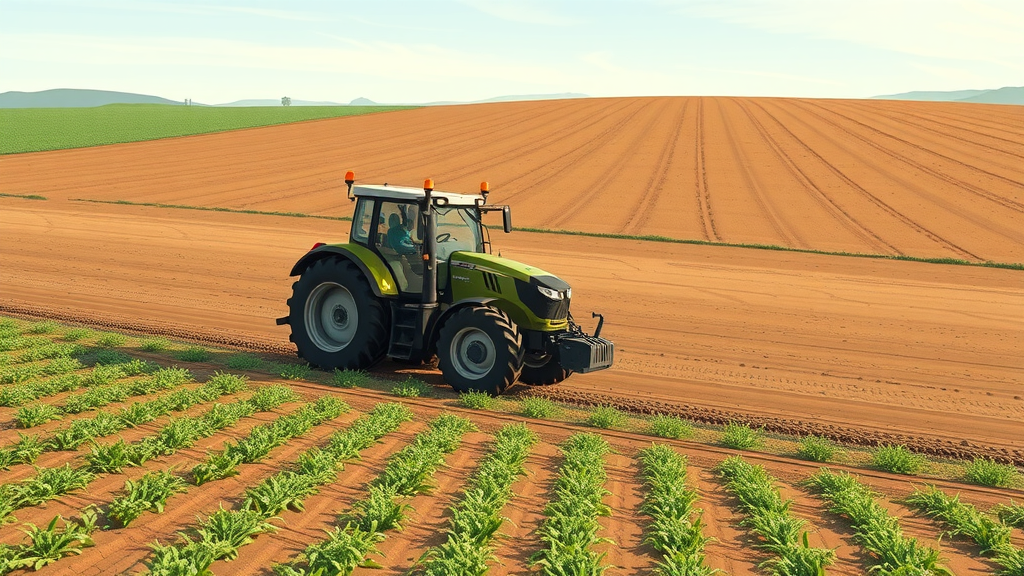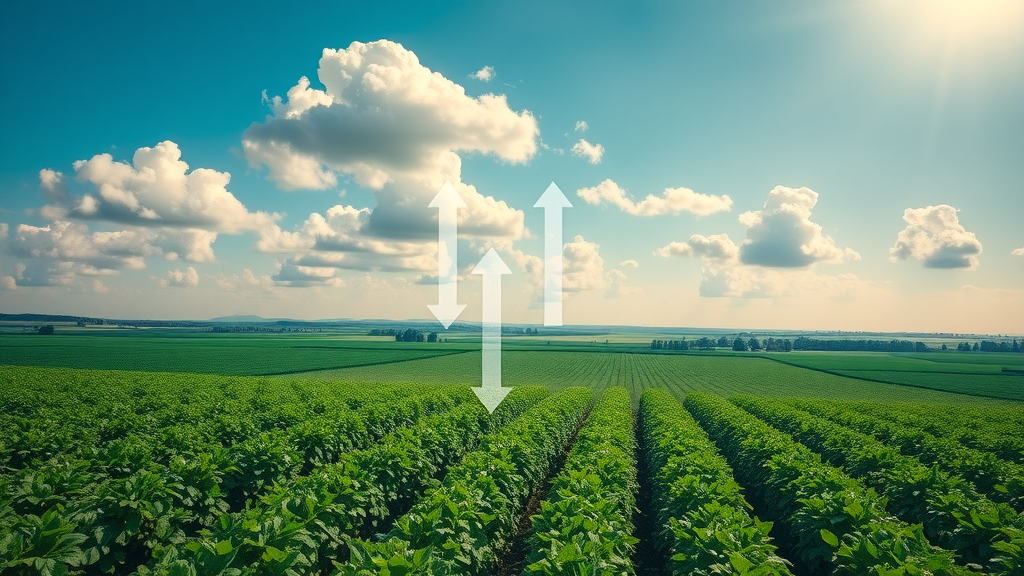Hook: Did you know that a single teaspoon of healthy soil contains more living organisms than there are people on Earth? This shocking fact underscores the profound power hidden beneath our feet—a power that regenerative farming is only just beginning to tap.
Startling Truth: Regenerative Farming’s Surprising Impact
Regenerative farming may sound like a buzzword, but its impact is anything but ordinary. This innovative approach to agriculture practice aims not just to maintain but to enhance soil health, revive biodiversity, and combat climate change—all while improving crop yields for farmers. Unlike conventional agricultural systems that often degrade soil through heavy tillage and chemical use, regenerative ag works with nature, encouraging soils teeming with life beneath every planting. The most exciting part? Even small changes in management practices can yield enormous benefits for the environment and your food system.
“A single teaspoon of healthy soil contains more living organisms than there are people on Earth.”—Dr. Elaine Ingham, Soil Microbiologist

What This Means for Agriculture Practices Today
Today’s agricultural systems face mounting challenges: soil erosion, shrinking biodiversity, frequent drought, and the growing threat of climate change. Regenerative farming offers practical, science-backed solutions to these issues. By nurturing healthy soil with principles like crop rotation, minimal soil disturbance, and the use of cover crops, farmers are actively restoring ecosystem services and making fields more resilient to extreme weather. This means not only healthier crops and higher crop yields, but also a path toward sustainable food production for generations. For those seeking to lower their carbon footprint and make eco-friendly choices, supporting regenerative agriculture could be one of the most powerful decisions you make.
What You’ll Learn About Regenerative Farming
- Core principles of regenerative agriculture and regenerative ag
- How cover crops and crop rotation boost soil health
- The environmental impact—climate change, greenhouse gas mitigation, and carbon sequestration
- Practical steps for transforming soil on a regenerative farm
- Comparisons between regenerative farming vs. traditional agriculture practices
Understanding Regenerative Farming: A Primer
What is Regenerative Farming?
Regenerative farming is an agriculture practice with a focus on improving soil health while working in harmony with natural ecosystems. Rather than simply sustaining current conditions or relying on synthetic inputs, regenerative agriculture seeks to restore and revitalize soil, promote biodiversity, and lock atmospheric carbon into the earth. This holistic approach is transforming food systems worldwide, proving that farmers can rebuild the land while harvesting bountiful, resilient crops.
“Regenerative farming goes beyond sustainability—its goal is to leave the land better than we found it.”

Core Principles of Regenerative Agriculture
At its heart, regenerative ag revolves around a few guiding tenets proven to support healthy soil and productive agricultural landscapes:
- Enhancing biodiversity—growing a mix of plants, integrating livestock, and cultivating habitats for soil microbes.
- Minimizing soil disturbance—reducing or eliminating plowing to preserve microbial life and organic matter.
- Maintaining soil cover—using cover crops to protect soil from erosion, retain moisture, and provide organic matter.
- Integrating livestock—mimicking natural grazing cycles, which foster nutrient cycling and improve pasture health.
These simple yet powerful management practices help break dependence on synthetic inputs and create thriving, self-sustaining agricultural systems.
Regenerative Ag Explained: How It Works
The Science of Soil Health in Regenerative Farming
Soil health stands at the center of regenerative ag. Healthy soil isn’t just dirt: it’s a complex ecosystem alive with soil microbes, fungi, plant roots, and organic matter that create a foundation for resilient crops. Practices like cover cropping and no-till farming increase soil organic matter and enable the natural resource cycles that underlie food production. Over time, these strategies reverse past damage and build deeper, more nutrient-rich soils that provide consistent yields despite climate stressors.

Why Healthy Soil Matters for Food Production
The life within healthy soil directly influences the quality and reliability of our food production. Soils rich in microbes and organic matter retain water longer, withstand drought, and reduce runoff that leads to soil erosion. For farmers, this translates into stronger crops with fewer chemical inputs and greater long-term yields—even as the climate becomes more unpredictable. For consumers, it means accessing nutrient-rich, sustainably produced foods that support eco-friendly living. Ultimately, improving soil health isn’t just good for farms; it’s vital for the future security of our entire food system.
Role of Microbes and Nutrient Cycling
Soil microbes are the unsung heroes of regenerative farming. Bacteria, fungi, earthworms, and beneficial insects break down organic matter, releasing nutrients through natural cycles that plants need to thrive. These organisms also help sequester carbon, trapping carbon dioxide in the soil and keeping it out of the atmosphere. Farmers who focus on nurturing these underground allies enjoy healthier soil, higher crop yields, and less reliance on fertilizers or pesticides. In fact, the ability to support vibrant soil life is what sets regenerative agriculture apart from conventional systems that disrupt these ecosystems through aggressive tilling or heavy chemical use.
Case Study: A Regenerative Farm’s Turnaround Story
Consider a regenerative farm in the United States that transitioned from conventional agriculture practice. Within three years of adopting a regenerative approach—using diverse cover crops, minimal tillage, and managed grazing—the farm’s soil organic matter increased by 30%, crop yields stabilized during drought, and new native species appeared across the property. This turnaround story isn’t unique: countless farms worldwide are experiencing similar results by prioritizing soil health and ecosystem balance. The lesson is clear—regenerative ag delivers measurable results for food production, the environment, and community livelihoods.
Key Regenerative Farming Practices
Using Cover Crops for Soil Health
Cover crops are one of the most effective tools in the regenerative farmer’s toolkit. Planted between main cash crops, these plants—such as clover, rye, or vetch—shield bare earth from erosion, add organic matter, and feed soil microbes. Root systems of cover crops improve soil structure by breaking up compacted areas and promoting water infiltration. When cover crops are incorporated or left on the land, they release vital nutrients, enriching soil for the next planting cycle. This simple practice helps build long-term soil health while reducing the need for synthetic fertilizers, supporting both eco-friendly living and resilient crop yields.

Crop Rotation—A Pillar of Regenerative Agriculture
Crop rotation is the practice of planting different types of crops in the same field in a defined sequence. By rotating crops each season, farmers disrupt pest and disease cycles that often plague monoculture systems. This practice also ensures that soil nutrients are replenished and not depleted. For instance, legumes fix nitrogen in the soil, boosting fertility for the next crop. Crop rotation, combined with cover crops and no-till practices, leads to improved soil health, higher crop yields, and sustainable food systems.
Minimizing Soil Disturbance
Conventional agriculture relies heavily on tillage, which, over time, damages soil structure, depletes organic matter, and harms beneficial microbes. Regenerative farmers turn to minimal-till or no-till methods to avoid these pitfalls. By limiting soil disturbance, they protect the intricate networks of fungi and roots that facilitate nutrient cycling and carbon sequestration. As a result, the land retains its moisture, releases fewer greenhouse gases, and is more resistant to extreme weather events. Minimal tilling is a cornerstone of regenerative practice, creating the conditions for healthy soil and sustainable food production.

Integrating Livestock on the Regenerative Farm
Many regenerative farmers introduce livestock—cattle, sheep, or chickens—using managed or rotational grazing to mimic natural animal movements. Their manure returns nutrients to the soil, and their movement fosters the breakdown of dead plant material, speeding up decomposition and nutrient cycling. This integration enhances biodiversity, contributes to building soil organic matter, and minimizes the need for chemical fertilizer. By restoring a natural balance, regenerative farms create robust, interconnected ecosystems supporting sustainable yields.
Polyculture & Biodiversity: Regenerative Ag in Action
Regenerative agriculture embraces polyculture: growing multiple complementary crops and supporting varied wildlife habitats on one plot. This enhances pest resistance, boosts crop production, and provides ecosystem services like pollination and erosion control. Biodiversity in regenerative ag is the engine for resilient farms and food systems—key to long-term eco-friendly living.
- Cover crops
- Crop rotation
- Companion planting
- No-till practices
- Managed grazing
The Environmental Benefits of Regenerative Farming
Carbon Sequestration: Fighting Climate Change
Soils managed under regenerative agriculture act as major carbon sinks. By increasing organic matter and fostering healthy soil microbes, regenerative farms draw down and store atmospheric carbon dioxide, directly combating climate change. Research shows that regenerative ag can sequester tons of carbon per acre annually—turning every healthy field into a valuable climate solution. Supporting these practices isn’t just about improving food—it’s about reducing greenhouse gas concentrations planet-wide.

Reducing Greenhouse Gas Emissions on a Regenerative Farm
Regenerative farming minimizes greenhouse gas emissions by cutting chemical fertilizer use—which is energy-intensive to produce and a source of nitrous oxide. Further, practices like no-till reduce fuel consumption and reduce soil carbon losses. By locking carbon in roots and organic matter, and leveraging managed grazing instead of synthetic feeds, regenerative ag reduces emissions across the board. As a result, every farm adopting these techniques helps move the needle on mitigating climate change.
Water Retention and Drought Resilience
Healthy soil acts like a sponge, capturing and holding onto rainfall, cutting irrigation needs, and preventing runoff. Regenerative practices like cover cropping and no-till farming build organic matter and create pore spaces that boost water retention, making both crops and communities more resilient to drought. In a changing climate, this water-holding capacity is one of regenerative agriculture’s most important ecosystem services, protecting food systems when conditions get tough.
Biodiversity Restoration Through Regenerative Agriculture
By enhancing biodiversity above and below ground, regenerative farms provide critical habitat for pollinators, beneficial insects, birds, and other wildlife. Greater species diversity stabilizes the system against pests and weather extremes, and improves crop yields over the long term. Biodiversity also enriches rural landscapes, supports local economies, and fulfills the promise of eco-friendly living for farmers and consumers alike.
Regenerative Farming vs. Conventional Agriculture Practices
| Aspect | Regenerative Farming | Conventional Agriculture |
|---|---|---|
| Soil Health | Improved, rich in organics | Often degraded |
| Greenhouse Gas Impact | Reduced emissions, carbon sequestration | Higher emissions |
| Biodiversity | Enhanced | Reduced |
| Water Use | Efficient, improved retention | Often wasteful |
| Food Production | Resilient, sustainable | High yields but less resilient |

The Magic of Soil Transformation—Practical Steps
Assessing Your Soil for Regenerative Farming
Before implementing regenerative practices, soil testing is crucial. Assess soil texture, organic matter, microbial activity, and nutrient levels—it’s the foundation for any successful transformation. Testing soil organically, with attention to biological indicators as well as chemistry, helps identify areas for improvement and track progress over time. Engaging agricultural extension services or a consulting soil scientist ensures an accurate starting point for your regenerative journey.

Building a Crop Rotation & Cover Crop Calendar
Planning is key to success in regenerative agriculture. Map out the sequence of cash crops and cover crops for the year, tailoring variety and timing to address specific soil health goals—like fixing nitrogen, breaking up compaction, or preventing erosion. Using a crop rotation and cover crop calendar ensures your soil is always protected and improving, maximizing biodiversity and nutrient cycling for sustained food production.
Implementing Minimal-Till or No-Till
Shifting away from traditional tillage may seem daunting, but starting small—with targeted no-till or strip-till methods—can quickly demonstrate benefits in soil health and organic matter retention. Use cover crops to suppress weeds naturally. As soil structure improves, equipment and fuel costs typically fall, and yields stabilize even in tough weather, reinforcing the power of this regenerative practice.
Measuring Success: Tracking Soil Health and Carbon Sequestration
Monitor progress by regularly checking soil organic matter, microbial activity, compaction, and crop performance. Invest in tools or services that help track carbon sequestration, as increased carbon in your soil is a visible sign of success. Document crop yields, input costs, and ecological changes over multiple seasons—this record will guide further improvements and help share results with your community or customers.
- Test soil organically
- Plan diverse crop rotations
- Plant multi-species cover crops
- Adapt grazing techniques
- Monitor organic matter build-up
Common Myths and Concerns About Regenerative Farming
Addressing Skepticism in Regenerative Ag Communities
Despite mounting evidence, some remain skeptical about regenerative farming’s scalability or its ability to feed a growing global population. Critics often point to higher initial work loads, possible dips in yields during the transition, or a lack of supportive infrastructure. However, pilot programs and case studies consistently show that, when properly managed, regenerative ag improves both soil health and food system resilience. Community education, peer-to-peer farm tours, and involvement of local extension experts help overcome doubts and spread the word about ecological and economic benefits.

Challenges for Farmers: Transitioning to Regenerative Practices
Transitioning from conventional agriculture practices to regenerative farming takes courage and commitment. Barriers include start-up costs for new equipment, learning new techniques like cover cropping or grazing management, and navigating uncertain markets. Despite these pain points, most regenerative farmers soon discover dramatic improvements in soil health, reduced input costs, and new opportunities for premium markets. Agricultural networks and supportive policies are steadily making the transition easier for farmers worldwide.
“Every transition has its pain points, but the payoff for healthier soil and communities is remarkable.”
Real-World Success Stories: Regenerative Farming in Action
Featured Regenerative Farm—Before and After
A once-barren plot, depleted by years of conventional tillage, is now a flourishing example of regenerative ag: cover crops bloom among market vegetables, bees and birds are abundant, and livestock graze contentedly, increasing organic matter year after year. Yields have stabilized, biodiversity has rebounded, and the community enjoys a healthy, locally grown food system.

Interviews with Pioneers in Regenerative Ag
Innovators in regenerative farming share common themes: a deep respect for the land, willingness to experiment, and commitment to sharing knowledge with neighboring farms. These pioneers have inspired a wave of interest in eco-friendly living and sustainable agriculture practice—proving that transformation is possible at every scale.
Measurable Results: Soil Health, Yield, and Community Impact
Third-party measurements confirm dramatic gains in soil organic matter, consistent crop yields, improved water retention, stronger local food systems, and enhanced community well-being. As regenerative practices spread, these results point toward a more resilient, climate-friendly food future for us all.
People Also Ask About Regenerative Farming
What is regenerative farming?
Answer: Regenerative farming is an agriculture practice that restores soil health, increases biodiversity, and sequesters carbon, improving the environment and producing resilient food systems.
Why are farmers against regenerative farming?
Answer: Some farmers hesitate due to upfront transition costs, knowledge gaps, market uncertainties, and the challenges of changing established agriculture practices.
Is regenerative farming good or bad?
Answer: Most research supports that regenerative farming is good for soil health, climate change mitigation, and resilient food production, but challenges remain in scalability and economic transition.
How is regenerative farming different from regular farming?
Answer: Regenerative farming emphasizes restoring soil health and ecological balance, unlike conventional approaches that often deplete soil and depend heavily on chemicals.
Frequently Asked Questions (FAQs) about Regenerative Farming
-
How quickly can soil health improve using regenerative farming methods?
With consistent application of regenerative practices like cover cropping and reduced tillage, measurable improvements in soil organic matter and microbial activity can often be seen within 1–3 years. -
What equipment is needed for regenerative agriculture?
Minimal-till or no-till drills, diverse cover crop seeders, fencing for managed grazing, and soil monitoring tools are some of the primary investments. -
Are regenerative agriculture products more expensive?
Regenerative products may have premium prices due to sustainable certification or smaller-scale production, but prices can decrease as market adoption grows. -
How do regenerative farms sequester carbon?
By increasing plant and microbial organic matter in soil, regenerative farms absorb and store atmospheric carbon through plant roots and residue. -
Does regenerative farming require livestock?
While livestock integration boosts nutrient cycling and soil health, regenerative practices can be adopted on both plant-only and mixed farms.
Key Takeaways: Eco-Friendly Living and Regenerative Agriculture
- Regenerative farming rebuilds healthy soil and boosts yields long-term
- Practices like cover crops and crop rotation mitigate climate change
- Communities benefit through food security and ecological resilience
Conclusion: Embracing Regenerative Farming for a Greener Future
“The future of farming is regenerative. Change your soil—change the world.”
Take the First Step to Regenerative Farming
Transform your land, join the regenerative ag movement, and contribute to the fight against climate change today.
Watch: Regenerative Farming Transformations
Regenerative farming offers a transformative approach to agriculture, emphasizing soil health, biodiversity, and climate resilience. For a comprehensive understanding of its principles and benefits, consider exploring the Chesapeake Bay Foundation’s article, Regenerative Agriculture, which details how these practices improve soil fertility, enhance water retention, and support wildlife habitats. Additionally, the Natural Resources Defense Council provides an insightful overview in Regenerative Agriculture 101, highlighting the ecological and economic advantages, including reduced chemical inputs and increased farm resilience. If you’re serious about adopting sustainable farming methods, these resources will equip you with the knowledge to implement regenerative practices effectively.
 Add Row
Add Row  Add
Add 



Write A Comment